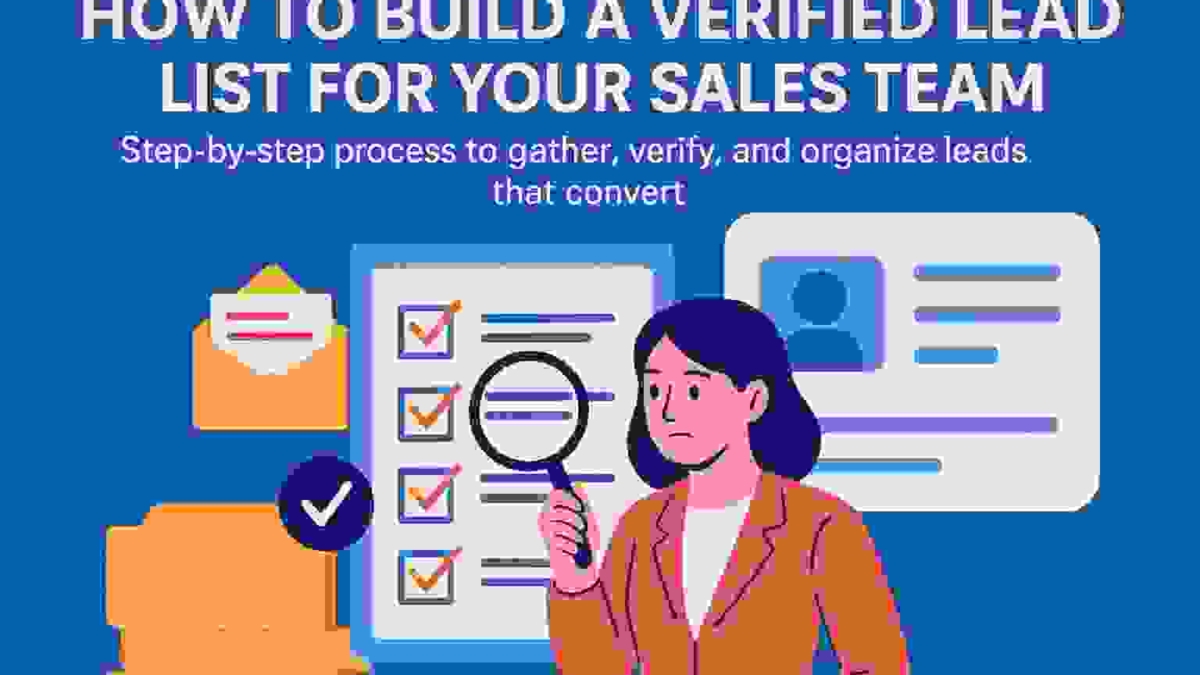Introduction
Every sales team dreams of one thing: a steady stream of high-quality leads. But here’s the catch—more leads don’t always mean more sales. The secret weapon is a verified lead list. It ensures your team spends time on prospects who are real, reachable, and ready to engage. In this guide, we’ll walk you through a practical, step-by-step process to build a verified lead list that actually converts.
Understanding Lead Lists
What is a Lead List?
A lead list is essentially a database of potential customers who might be interested in your product or service. But not all lead lists are equal. A raw list may have random emails, outdated info, or even fake contacts.
Raw Leads vs. Verified Leads
-
Raw Leads: Unfiltered, often inaccurate, and sometimes purchased in bulk.
-
Verified Leads: Carefully checked, validated, and ready for your sales team to approach.
Think of it like fishing: raw leads are the ocean, while verified leads are the fish already in your net.
Benefits of a Verified Lead List
-
Higher Conversion Rates – Talking to the right people increases your chances of closing deals.
-
Time Efficiency – Your sales team spends less time chasing dead ends.
-
Better Deliverability – Verified emails reduce bounce rates and keep your domain reputation safe.
Step 1 – Define Your Ideal Customer Profile (ICP)
Before gathering leads, you need a clear Ideal Customer Profile. Ask yourself:
-
Which industries do we serve best?
-
What job titles make purchasing decisions?
-
What company size fits our solution?
Without a clear ICP, you’ll end up with a bloated, irrelevant list.
Step 2 – Choose the Right Lead Sources
Not all sources are created equal. Some of the best ones include:
-
LinkedIn – The ultimate B2B goldmine.
-
Lead Databases – Tools like ZoomInfo, Apollo, or Clearbit.
-
Company Websites – Direct and accurate.
-
Communities – Forums, niche groups, or even Reddit.
Step 3 – Use Lead Generation Tools
Manual research is time-consuming. Instead, use tools like:
-
Hunter.io – For email discovery.
-
Apollo.io – For full lead profiles.
-
Lusha – For verified phone numbers.
-
HubSpot CRM – For managing leads.
These tools help automate data collection without sacrificing accuracy.
Step 4 – Collect Essential Data
At minimum, your lead list should include:
-
Full name
-
Job title
-
Company name
-
Email address
-
Phone number (if available)
Extra fields like LinkedIn profile or company revenue can also help with personalization.
Step 5 – Verify Contact Information
Here’s where the magic happens. Use tools like NeverBounce, ZeroBounce, or Kickbox to verify emails. For phone numbers, cross-check with company directories or LinkedIn profiles. A single unverified lead can waste hours of your team’s time.
Step 6 – Clean and Organize Your Lead List
-
Delete duplicates.
-
Ensure consistent formatting (first name, last name, etc.).
-
Segment by priority (decision-makers vs. influencers).
A clean list = a happy sales team.
Step 7 – Prioritize and Score Leads
Not all leads are equal. Use lead scoring:
-
High-value: Matches ICP, verified, high intent.
-
Medium-value: Fits ICP but lacks engagement.
-
Low-value: Poor fit or incomplete data.
Automation tools like HubSpot or Zoho can score leads automatically.
Step 8 – Import into CRM
A verified list is useless if not properly integrated. Import it into your CRM with:
-
Tags for segmentation
-
Notes for personalization
-
Categories for follow-ups
Step 9 – Keep Your List Fresh
Data decays quickly—people change jobs, companies shut down, and emails stop working. Refresh your list every 30–60 days to maintain accuracy.
Step 10 – Train Your Sales Team
Even the best list fails if your sales team doesn’t use it well. Train them on:
-
Personalizing outreach messages
-
Using lead data for context
-
Aligning with marketing campaigns
Common Mistakes to Avoid
-
Buying bulk lists blindly – Most are outdated or fake.
-
Skipping verification – Leads to wasted effort.
-
Overloading sales reps – Too many leads cause burnout.
Tools and Resources
-
Email Verification – NeverBounce, ZeroBounce, Bouncer.
-
CRMs – HubSpot, Salesforce, Zoho.
-
Lead Gen Tools – Apollo.io, Hunter.io, Lusha.
Conclusion
Building a verified lead list isn’t just about gathering names and emails—it’s about finding the right people, verifying their info, and keeping it fresh. By following these steps, your sales team will have the confidence to reach out to prospects who are not only real but also ready to listen.
FAQs
1. What is the best tool for verifying emails?
NeverBounce and ZeroBounce are among the most reliable.
2. How often should I clean my lead list?
Every 30–60 days is recommended.
3. Should I buy leads or generate them?
Generating is safer and higher quality, but if you buy, always verify first.
4. What data fields are most important in a lead list?
Name, job title, company, and verified email are must-haves.
5. How do I make sure my sales team actually uses the list?
Train them, integrate the list into your CRM, and keep it regularly updated.


Leave a comment